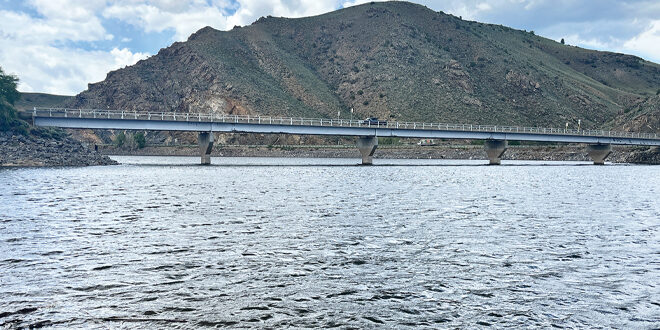(Reprinted with permission of the Montrose Daily Press)
By Katharhynn Heidelberg
If you drive between Gunnison and Montrose very often, you may have noticed Blue Mesa Reservoir is filling up.
It’s not your imagination. As of last week, the state’s largest body of water was 16 feet from being full to the brim. That means 685,000 acre-feet sitting in the reservoir right now, with spring runoff from a snowy winter not quite finished.
“That’s way better than anybody thought it would be this year,” Bureau of Reclamation (BuRec) hydrologist Erik Knight said Monday, June 12. “It’s going to get close (to filling). If it doesn’t, it will probably be within 5 feet.”
The BuRec manages Blue Mesa and other reservoirs and dams that are part of the Aspinall Unit, impounding and storing Gunnison River water.
The Gunnison Tunnel, which brings vital irrigation water to the Uncompahgre Valley, has taken its full amount at about 1,000 cubic feet per second (cfs). The power plant at Crystal Dam is at full capacity and the river downstream from the tunnel is flowing at about 1,000 cfs.
That’s a far cry from the situation in recent years, which saw the reservoir drop so low that under the Lake City bridge was hardly more than a trickle cutting through a drying stream bed.
In 2021, drought was so dire in the West that provisions of the Colorado River Drought Contingency Plan kicked in, and BuRec was obliged to release water from the already hurting Blue Mesa to Lake Powell, to keep that reservoir from dropping below the levels necessary for power plant turbines at the Glen Canyon Dam.
Knight said no releases from Blue Mesa to prop up Powell are expected this year. The larger reservoir, though, is not in perfect shape and the water crisis on the Colorado River remains.
This past winter, however, brought thick snows to the high country in the Gunnison Basin, leaving above-average snowpack — and even as spring comes to an end, some of that snow has yet to come down as runoff. Temperatures have been uncharacteristically lower, plus there has been rain, leaving a colder, wetter spring.
“Everything’s been quickly evolving during the spring; lots of changes,” Knight said.
Ridgway Reservoir, fed by the Uncompahgre River and Dallas Creek, is also in good shape, said Steve Pope, manager of the Uncompahgre Valley Water Users Association (UVWUA).
“It’s climbing every day. We looked at it this (Monday) morning. It was about 15,000-16,000-acre feet from being full. We’re picking up 800-acre feet a day,” Pope said.
Ridgway Reservoir, managed by Tri-County Water Conservancy District, is one of the storage pots for UVWUA water.
Pope noted there is still snow sitting in the high country above the reservoir that has yet to come down. He said excess would be bypassed through the headgates.
“We’re looking at not really needing to use any of our reservoir storage for quite some time, probably into August,” Pope said. “We feel like we’re in a pretty comfortable position right now.”
He also said the longer, lower temperatures pushed runoff later into the year. That’s what helped the most.
“We’re trying to get as much of it as we can into our system. All the irrigators are going great guns. There aren’t any shortages,” Pope said.
Overall, the wet winter and spring brought western Colorado some breathing room.
“It’s definitely bought us a year or two,” Knight said.
Of course, conditions can change, and can change dramatically in a relatively short time. Blue Mesa looked very good in 2019, but thereafter came low-water years. As all water managers know, nothing is a given.
“We could be right back into a drier scenario next year,” said Pope. “We’re enjoying the reprieve and hoping it stays this way.”
 The Crested Butte News Serving the Gunnison Valley since 1999
The Crested Butte News Serving the Gunnison Valley since 1999




